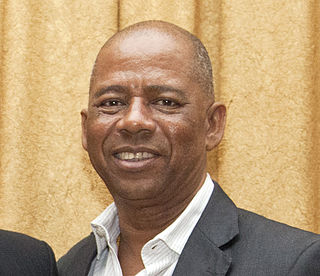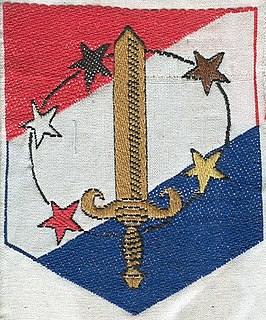This article relies largely or entirely on a single source .(April 2018) |

The Ministry of Colonies was a Dutch ministry that arranged all matters relating to the Dutch colonies.
This article relies largely or entirely on a single source .(April 2018) |

The Ministry of Colonies was a Dutch ministry that arranged all matters relating to the Dutch colonies.
After the dissolution of the West India Company, a Council of the American Colonies and Possessions was established, which in 1806 was rescinded under King Louis Napoleon Bonaparte. [1] Instead, the Ministry of Commerce and Colonies was established on 29 July 1806, headed by Paulus van der Heim. This ministry was transformed on 8 July 1808 into the Ministry of Marine and Colonies, again under Van der Heim. [1]
During the incorporation of the Netherlands at the First French Empire on 13 July 1810, the ministry continued as a separate division (Division Hollandaise) under the French Ministère de la Marine et des Colonies in Paris. [1]
After the French were defeated in 1813, a Department for the Business of Commerce and Colonies was established on April 6, 1814, headed by Godert van der Capellen, as "Secretary of State". He was succeeded on 29 July 1814 by Joan Cornelis van der Hoop. Subsequently, on 16 September 1815, the title of "Secretary of State" was replaced by that of "Director-General", Johannes Goldberg was the first to wear this title. Until 1842 the Colonies, with the exception of the period between January 1, 1834 and August 9, 1840, was united with other departments: successively as:
After 1 January 1842 Colonies became an independent ministry. [1]
On 23 February 1945 the name was changed to the Ministry of Overseas Territories. In 1951 the name was changed to the Ministry for Union Affairs and Overseas Departments, followed by the Ministry of Overseas Territories in 1953. in 1957 the name was changed again, now in the Ministry of Overseas Affairs.
Because of the decolonization, the ministry ceased to exist as an independent department in 1959.[ citation needed ] It became a separate "cabinet" (department), first under the Vice Prime Minister (1959-1971), [1] later as:
In 1998, this government was included in the new Ministry of the Interior and Kingdom Relations. [1]
The ministry had its own armed forces. From 1816 the Dutch East Indies Army (from 1836 Royal Netherlands East Indies Army, KNIL) fell under the Ministry of Colonies. Also the Force in Suriname (TRIS) and its predecessors fell from 1868 to 1957 under the ministry or its successors. The KNIL was dissolved in Indonesia during the sovereignty transfer to Indonesia in July 1950. The TRIS, which from 1957 was part of the Royal Netherlands Army, was abolished after the transfer of sovereignty to Suriname in 1975. [1]
From 1829 the ministry was located in the Huygenshuis. In 1860 an own ministerial building was built in The Hague, the first ministerial building that was designed as such. During the Second World War, the ministry was based in London from 1940 to 1945. From 1959, the cabinet was located at Plein 1813.

The Netherlands Antilles was a constituent country of the Kingdom of the Netherlands. The country consisted of several island territories located in the Caribbean Sea. The islands were also informally known as the Dutch Antilles. The country came into being in 1954 as the autonomous successor of the Dutch colony of Curaçao and Dependencies and was dissolved in 2010. The Dutch colony of Surinam, although it was relatively close by on the continent of South America, did not become part of the Netherlands Antilles but became a separate autonomous country in 1954. All the island territories that belonged to the Netherlands Antilles remain part of the kingdom today, although the legal status of each differs. As a group they are still commonly called the Dutch Caribbean, regardless of their legal status. People from this former territory continue to be called Antilleans (Antillianen) in the Netherlands.

Dutch colonisation of the Guianas—the coastal region between the Orinoco and Amazon rivers in South America—began in the late 16th century. The Dutch originally claimed all of Guiana but—following attempts to sell it first to Bavaria and then to Hanau and the loss of sections to Portugal, Britain, and France—the section actually settled and controlled by the Netherlands became known as Dutch Guiana.

The Royal Netherlands East Indies Army was the military force maintained by the Kingdom of the Netherlands in its colony of the Dutch East Indies, in areas that are now part of Indonesia. The KNIL's air arm was the Royal Netherlands East Indies Army Air Force. Elements of the Royal Netherlands Navy were also stationed in the Netherlands East Indies.

Berbice is a region along the Berbice River in Guyana, which was between 1627 and 1815 a colony of the Dutch Republic. After having been ceded to the Kingdom of Great Britain in the latter year, it was merged with Essequibo and Demerara to form the colony of British Guiana in 1831. In 1966, British Guiana gained independence as Guyana.

The rijksdaalder was a Dutch coin first issued by the Republic of the Seven United Netherlands in the late 16th century during the Dutch Revolt. Featuring an armored half bust of William the Silent, rijksdaalder was minted to the Saxon reichsthaler weight standard – 448 grains of 0.885 fine silver. Friesland, Gelderland, Holland, Kampen, Overijssel, Utrecht, West Friesland, Zeeland, and Zwolle minted armored half bust rijksdaalders until the end of the 17th century.

The Central Bank of Suriname is Suriname’s highest monetary authority and the country’s governing body in monetary and economic affairs.

The Ministry of the Interior and Kingdom Relations is the Netherlands' ministry responsible for domestic policy, civil service, public administration, elections, local governments, intelligence, and kingdom relations.

The Netherlands Antilles was an autonomous Caribbean country within the Kingdom of the Netherlands. It was dissolved on 10 October 2010.

The Kingdom of the Netherlands, commonly known as the Netherlands, is a sovereign state and constitutional monarchy with 98% of its territory and population in Western Europe and with several small West Indian island territories in the Caribbean.

Antoon Arnold Marie "Teun" Struycken was a Dutch jurist and politician, co-founder of the Catholic People's Party (KVP) – now merged into the Christian Democratic Appeal (CDA).

The Caribbean Netherlands are the three special municipalities of the Netherlands that are located in the Caribbean Sea. They consist of the islands of Bonaire, Sint Eustatius and Saba, although the term "Caribbean Netherlands" is sometimes used to refer to all of the islands in the Dutch Caribbean. In legislation, the three islands are also known as Bonaire, Sint Eustatius and Saba or the BES islands. The islands are currently classified as public bodies in the Netherlands and as overseas countries and territories of the European Union; thus, EU law does not automatically apply.

The Colony of Curaçao and Dependencies was a Dutch colony from 1634 until 1828 and from 1845 until 1936. Between 1936 and 1948, the area was officially known as the Territory of Curaçao, and after 1948 as the Netherlands Antilles. With the proclamation of the Charter for the Kingdom of the Netherlands on 15 December 1954, the Netherlands Antilles attained equal status with the Netherlands proper and Suriname in the overarching Kingdom of the Netherlands.

The current Constitution of Suriname was adopted on 30 September 1987, following a referendum. It marked the return to democracy after the Bouterse military dictatorship of the 1980s.

Suriname was a constituent country of the Kingdom of the Netherlands between 1954 and 1975. The country had full autonomy, except in areas of defence, foreign policy, and nationality, and participated on a basis of equality with the Netherlands Antilles and the Netherlands itself in the Kingdom of the Netherlands. The country became fully independent as the Republic of Suriname on 25 November 1975.

Surinam was a Dutch plantation colony in the Guianas, neighboured by the equally Dutch colony of Berbice to the west, and the French colony of Cayenne to the east. Surinam was a Dutch colony from 26 February 1667, when Dutch forces captured Francis Willoughby's English colony during the Second Anglo-Dutch War, until 15 December 1954, when Surinam became a constituent country of the Kingdom of the Netherlands. The status quo of Dutch sovereignty over Surinam, and English sovereignty over New Netherland, which it had conquered in 1664, was kept in the Treaty of Breda of 31 July 1667, and again confirmed in the Treaty of Westminster of 1674.

Winston Guno Lackin was a Surinamese politician. He was Minister of Foreign Affairs of Suriname in the cabinet of President Dési Bouterse between 13 August 2010 and 13 August 2015.

The 1st Infantry Battalion of the Royal Netherlands East Indies Army was a Dutch colonial military unit that was active in the Dutch East Indies during World War II and the Indonesian National Revolution.
The Van Mook-MacArthur Civil Affairs Agreement was an agreement between the United States and the Dutch government-in-exile. It concerned the jurisdiction over and administration of civil affairs in Dutch East Indies territory liberated by an Allied expeditionary force during WWII.

The Netherlands Armed Forces in Suriname was the military force maintained by the Kingdom of the Netherlands in its colony of Suriname, in the area that is now independent Republic of Suriname.

The Military Mission for Indonesia was a military training and advice programm for the Indonesian army (TNI) by the Dutch military personnel (KL) it lasted from 1950-1954.